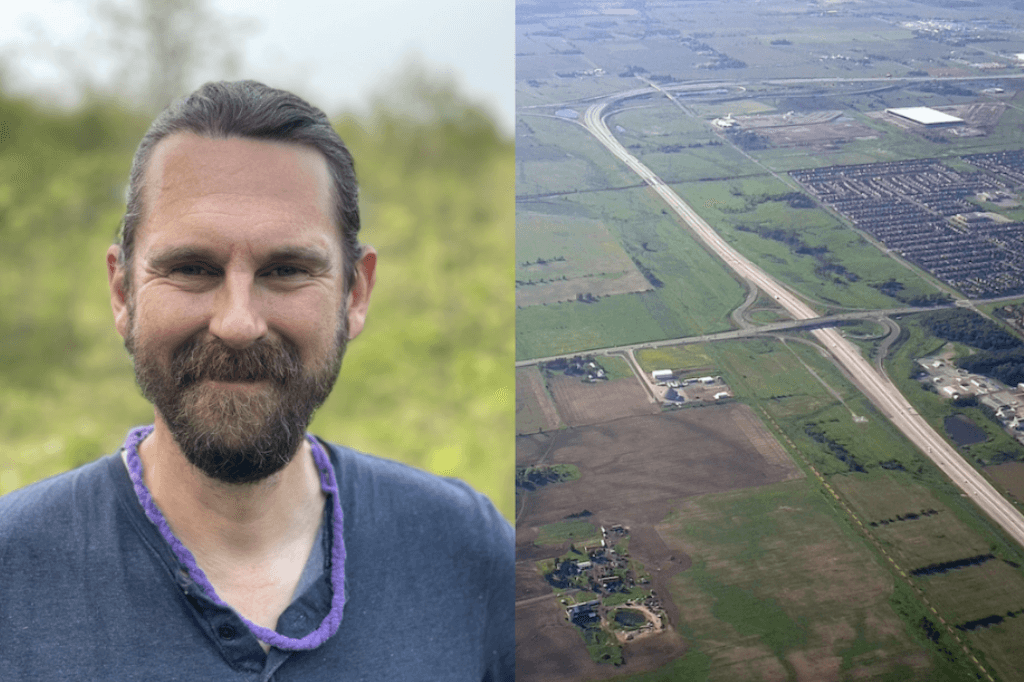University of Guelph biologist Ryan Norris used to believe “science takes part but shouldn’t take sides.” Now he’s urging peers to protest not only Highway 413 but also threats to nature more broadly.

In 2021, biologist Ryan Norris organized an open letter urging the federal government to conduct an impact assessment on the expressway. (Left: Courtesy of Ryan Norris; Right: Haljackey/Wikimedia)
While the Ontario government continues to plan and design Highway 413, scientists are increasingly vociferous in their opposition to the project, citing its destruction of top agricultural land and threats to rare animals living along the 52-kilometre route from Vaughan to Milton.
Within the scientific community, perhaps no one is more critical of the 413 than University of Guelph biologist Ryan Norris.
In April 2021, Norris organized an open letter, signed by over 50 scientists, urging former federal environment minister Jonathan Wilkinson to conduct an impact assessment on the expressway. In May of that year, the minister agreed to do that, saying concerns expressed in the scientists’ letter were a factor in his decision. (Ottawa recently made a tentative deal with the province to abandon a federal assessment of the highway.)
The following year, Norris led a group of journalists on a tour of Vaughan’s Nashville Conservation Reserve, a part of the Greenbelt the highway would pave. They got to see up close what would be destroyed if the project went ahead.
Wearing a yellow rain jacket and binoculars at his chest, Norris stood before the TV cameras and explained that the 413 would harm endangered fish, such as the redside dace, and at-risk birds, such as the red-headed woodpecker. He pointed out steep bluffs along the Humber River where swallows might nest. He crouched in a meadow searching for monarch-butterfly eggs on milkweed. And he planted in the minds of the assembled reporters a question: “Is this any place for an expressway?”
Norris recently chatted with me from Algonquin Park, the location of some of his academic research. We discussed his life and work and his changing views on the role of scientists in society.
He was raised in Toronto’s Etobicoke district. His passion for biology was not immediate — he was not one of those who, at age three, knew he wanted to study snakes. “I grew up in an urban world and didn’t necessarily have … nature-loving parents, either,” he recalls. “So I really got hooked on biology … when I was an undergraduate at the University of Waterloo.”
His first job in the field took him to Algonquin Park to study wolves. “I really got into that, like nothing I’d ever gotten into before in my life,” he says. But his calling was elsewhere: “I discovered that I actually had even more of a fondness working on birds.”
Norris’s doctoral research focused on a tiny migratory songbird, the American redstart, that weighs only eight grams yet can fly from Ontario to Mexico or the Caribbean. Norris posed an intriguing question: If the bird’s southern habitat is degraded, does that harm its ability to breed when it returns to Canada?
He discovered the answer is yes. “I showed that the higher-quality habitat a redstart used in the Caribbean or Mexico … the higher reproductive success they had in the subsequent breeding season.” The implications for conservation were clear: although the birds mate in Canada, we need to protect their habitat both in this country and abroad. “We can’t just manage things from up here,” Norris says. “We have to manage them and conserve them throughout their annual cycle.”
In 2022, Norris co-authored a landmark report on Highway 413’s environmental impact titled “The Road to Our Ruin.” He found that the project would destroy hundreds of acres of Greenbelt and harm at least 29 species protected under the federal Species at Risk Act.
I asked Norris what aspect of the 413, in his view, would be most detrimental. He hesitated. It isn’t one thing, he explains: “It’s the whole package.” The expressway will create harmful noise, nutrient runoff, and, above all, loss of natural habitat — the loss will be due not only to the highway itself but also to the development that will grow up beside it.
It’ll be, he said, “just an enormous mega-sized bulldozer going through.”
The project would also affect wildlife in subtler ways. Norris tells me about a threatened bird, the wood thrush, that’s found near the 413’s proposed route and displays what he calls “neophobia,” literally a fear of the new. Here, the threat is not that the tree containing its nest will be chopped down but that, due to highway construction, the bird’s whole neighbourhood will become unfamiliar. “You change their surroundings, and that is a cause for alarm for a lot of these species,” Norris says. “And that would be enough for them to say, ‘I’m out of here. I’m going somewhere else.’” In the densely populated GTHA, there may not be somewhere else to go to.
To appreciate the full extent of the 413’s destructiveness, it’s important to understand the significance of its location. Southern Ontario is Canada’s most urbanized area but, as Norris points out, it’s also one of our most biologically diverse regions. That means the 413 would pave a part of the province that’s capable of sustaining a rich variety of flora and fauna but that has lost much of its natural heritage. The tragedy is putting a highway precisely where nature has been decimated yet has such potential to flourish.
I asked Norris whether scientists have a responsibility to weigh in on public issues. While he says yes, his position has evolved. “I started off my career thinking that science takes part but shouldn’t take sides,” he says, citing the conventional view that scientists are observers, not activists.
Then the biodiversity crisis emerged. “And I think that’s what’s changed my mind about it,” he says, adding that he now believes it’s not enough for academics simply to publish papers. When it comes to current affairs concerning their discipline, they need to speak out: “I think that scientists are perfectly capable of being advocates as long as they can back it up by their own reasoning and evidence and logic.”
Norris now urges his peers to protest not only Highway 413 but also threats to nature more broadly.
“My feeling,” he says, “is we just don’t have the luxury anymore as scientists to not be advocates.”
This article was originally published as in TVO today.
